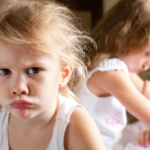
20 May Family meals during the pandemic: The good, the bad and the struggle
Jo Lindsay, Claire Tanner and Deana Leahy report on their research with families with primary school-aged children last year, and they found that the ideal of the shared family meal around a table was a challenging ritual to put into practice. This was particularly the case for families where both parents were engaged in paid work.
The clashing temporalities of school, work, commuting, and children’s after-school activities made having a meal together on a nightly basis a near impossibility for many families.
But now, in the middle of a global pandemic, nearly every parent is a stay-at-home parent, children’s sports and other extracurricular activities have been cancelled, commuting times have been cut, and we’re confined to our houses. This change in the structural conditions of everyday life may enable for many a slower, more traditional approach, to family food preparation and shared consumption.
 While food may have become a focus of family fun for some, for other families … the challenge of putting food on the table is an everyday reality that has just got even harder.
While food may have become a focus of family fun for some, for other families … the challenge of putting food on the table is an everyday reality that has just got even harder.
The spike in grocery sales and decline in takeaway sales suggest that many Australian families who could afford to buy in bulk to prepare for isolation are now spending more time cooking and eating together within their households.
Of course, while many people (over)stocked their pantries and cupboards, others, including the elderly and those with disabilities, missed out. At the same time, cafes and restaurants closed their doors and were left with overflowing stocks of fresh produce going to waste.
Yet social media is largely telling a positive story about family meals, flooded with recipes and examples of impressive meals cooked from scratch, and baked family favourites.
There’s a new focus on meal planning with the “once-a-week shop” and slow domestic food production, including old-fashioned pickling, fermenting, and sourdough baking becoming new hobbies.
People are trying new recipes and making do with ingredients on hand. Vegetable gardening has escalated rapidly in some places, with plant nurseries selling out of productive seedlings. Despite shortages of some staple items, fresh food remains abundant in greengrocers and smaller supermarkets.
Celebrity chefs discuss their “lockdown larder“, telling us to keep cooking and carry on.
Away from the spotlight, people such as Jack Monroe have been helping people secure food and cook on a bootstrap long before many had experienced the pressures of what’s now commonly referred to as a pandemic pantry. The pandemic pantry has been an everyday reality for disadvantaged families long before the pandemic, where struggling to get food and meals on the table is becoming more difficult.
So while the pleasure of sharing family meals may be one of the good things to come out of the COVID-19 public health crisis, it’s by no means a universal experience. For some, dinner provides a structure and formality at the end of the new working-at-home day.
On social media platforms, pictures of families sitting around tables laden with food abound. Parents of older teenagers and young adults report that shared cooking and eating of family meals with their children is an unexpected “bonus” of the pandemic, and coming together over cooking is creating opportunities for “precious time” together as young people are not able to go out with their friends.
While food may have become a focus of family fun for some, for other families, especially single-parent households, the challenge of putting food on the table is an everyday reality that’s just got even harder as much-needed income and casual and part-time jobs have been lost.
For others, food provisioning has gone into survival mode. This is particularly the case for employed parents with young children who are trying to work from home with no grandparent support, childcare or school. Parents report their homes have turned into informal childcare centres or home schools while they engage in split-shift parenting, taking turns to have the kids and working long into the night to meet their work/care demands.
In isolation, food preparation and other domestic tasks have also increased, with more people in the home and increased numbers of mouths to feed at every mealtime. Working parents, and mothers in particular, are being required to absorb this added workload while caring for children and meeting work responsibilities at the same time.
Many family relationships are under stress financially, with relationships under pressure, and domestic violence an escalating problem.
Existing tense family relationships are unlikely to be smoothed over with more time to cook or involving more people in the cooking process as some cooking shows are advocating.
When movement restrictions were lifted in China, the numbers of people filing for divorce rapidly increased. There’ll be more families facing food insecurity as the predicted economic recession bites. Unlike the UK, most Australians have little experience of living under austerity conditions.
Already, food charities report struggling with lower amounts of donated food, and a reduction in volunteer labour – making it challenging to get food to families in need. Yet there’s also innovation and agility in the charity sector in Australia, with organisations such as Cultivating Community banding together with local cafes and restaurants to redirect significant amounts of food to those in need in their neighbourhoods.
So, the experience of family meals may very much depend on where you are in the family life cycle, and where you are in terms of financial security. The social gradient may end up having the greatest impact on the experience of family meals during the pandemic – as it does for public health outcomes more generally.
For the financially secure, healthy food is plentiful, and there’s more time to devote to preparing and sharing family meals. At the other end of the social gradient, families are struggling to get meals on the table, and more will go hungry as we head to more austere times.
This article was first published on Monash Lens. Read the original article




